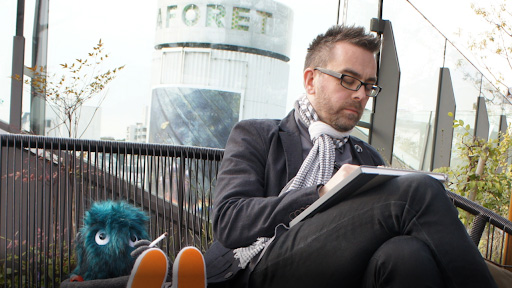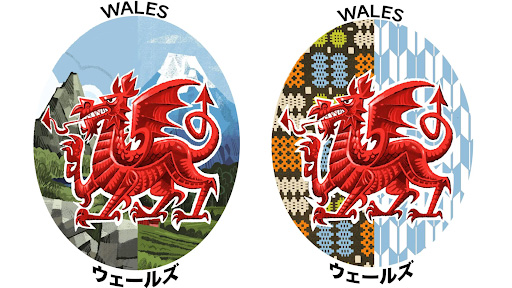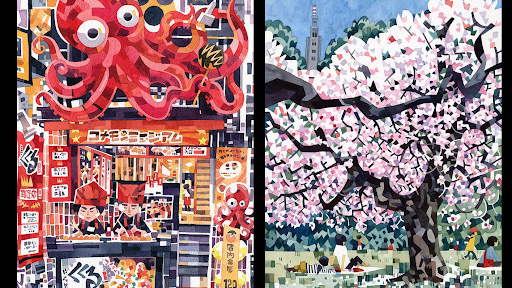Jonathan Edwards designed stamps blending the Welsh dragon with Japanese sites to celebrate the Year of Wales and Japan. What inspired him to merge Celtic myth with Japanese traditions?

In a peaceful farmhouse on a mountain in Sakurai, Jonathan Edwards felt a sense of déjà vu. While driving through the Japanese countryside 19 years earlier, the Welsh illustrator noticed that the gently rolling hills of rural Japan looked surprisingly similar to his hometown in Wales.
“Just driving through the Japanese countryside, I was amazed how much it reminded me of the Welsh countryside,” Jonathan said. “Even this last week, we were away in Wales in a cottage. And there were so many times when I thought I was in Japan.”
Jonathan discovered his passion for illustration in childhood, inspired by Japan. He was drawn to Japanese manga and comics, which sparked his interest in drawing and influenced many of his artistic choices.
“I remember doing school projects and getting these books out of the library and just really falling in love with woodblock prints and kimono fabrics and the look of Japan,” Jonathan said.

Japanese investment in Wales began in 1972, and now around 60-70 Japanese-owned companies are operating in Wales employing thousands of Welsh people. A £150,000 Wales Japan Culture Fund will shortly be launched for activities connecting Wales and Japan this year.
Jonathan has designed a unique series of five stamps to celebrate the collaboration. Each one features the iconic red Welsh dragon combined with Japanese elements, including Fuji Mountain. The red dragon, a national symbol that Jonathan said he never really thought about how unusual it is as a flag until encountering reactions from other countries.
“I tried to redesign it a bit, but you really have to stay close to what people recognise as the Welsh dragon,” he said. “The first sketches I did for the stamp were quite far removed from the traditional version, but I decided to bring it back to something more familiar and recognisable.”
Jonathan’s work has appeared on everything from Guardian Guide covers to the album art for The Black Eyed Peas, but Japan has remained a constant inspiration. His sketchbooks, filled on cafe tables and train rides across Tokyo, Kyoto, and Osaka, have been turned into prints. “Drawing takes me back,” he said.

During his visits, Jonathan observes connections between Welsh folklore and Japanese mythology. He said, “There’s sort of similarities between Welsh stories like Bloodweath, and Japanese folklore and yokai culture. I can see a lot of parallels. And the more I speak to people, the more connections I find as well.”
He also noticed differences in lifestyle between the two countries. Edwards was particularly struck by Japan’s emphasis on cleanliness, manners, and efficiency. “I think British culture is a bit more lackadaisical, things will get done when they get done. We’re not quite as efficient as Japan. Things like train times. And that must be weird for Japanese people living in the UK as well.” said he.
For him, travel illustration functions as both documentary practice and economic strategy. During his visits to Japan, Jonathan established a disciplined drawing routine. “I did one painting a day while I was there in a sketchbook. I also took a very small A5 sketchbook, which I took with me everywhere. And every time I sat down in a cafe or on a train, I tried to draw something.”

These drawings, later published as books and sold as prints, generate sufficient income to fund subsequent trips which creates a self-sustaining cycle of creative production.
Jonathan has also drawn inspiration from Japanese artists. A visit to a Tokyo exhibition of Akira Katsuno, a 90-year-old illustrator whose career spans from the 1930s to the present, told Jonathan about the possibility of insisting on a lifelong career. “The first piece was, I think, produced in the thirties when he was in his teens. And the last piece was a record cover he did for a Japanese band last year when he was in his nineties.”
Jonathan also shared his concerns about staying stagnant and not evolving with the times, especially with the rise of AI creation. He compared AI artwork to someone handing you a crossword or Sudoku puzzle that’s already been filled in or simply giving you the answers.
“I’ve never wanted to do anything else,” he said, “I can’t imagine if I had to give up illustration, having to get some other type of job. Just carry, carry on as much as you can.”
